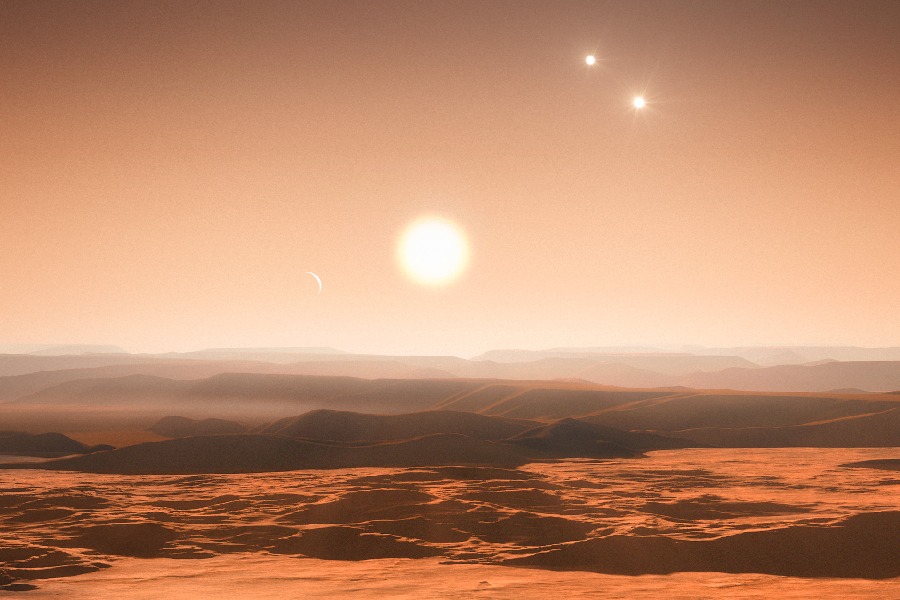Within our galaxy, countless stars twinkle, each harboring fascinating worlds. Among them, the Gliese 667 star system, nestled around a diminutive red dwarf star, stands out. This system boasts a plethora of exoplanets, with one in particular, Gliese 667 Cc, capturing attention. So, what are the key characteristics of this celestial wonder?
In this article, we examine Gliese 667 Cc’s probable climate, given the radiation from its aging host star. We will also explore how astrobiologists assess this planet’s potential to host life compared to other nearby exoplanets. Let’s dive deeper to unravel some Gliese 667Cc facts!

Gliese 667 Cc
Gliese 667 Cc, situated in the Gliese 667 star system near our Solar System, is an exoplanet that falls into the category of potentially habitable planets. This designation implies that it might have conditions suitable for supporting life.
Scientists are actively studying Gliese 667 Cc to investigate the potential for extraterrestrial life. What makes it particularly interesting is its proximity to our Solar System, which is located in a nearby star system.
This exoplanet is crucial in our ongoing exploration to understand habitability and the broader possibilities of life beyond Earth. The research conducted on Gliese 667 Cc contributes significantly to our quest for knowledge about the potential existence of life in the universe.
Background of Gliese 667 Cc
The Gliese 667 C star, a diminutive and cool red dwarf, shines roughly 1.4% of the Sun’s brilliance. Nestled within a triple star system, situated a mere 22 light-years away, Gliese 667 C is the least luminous among its stellar companions. This celestial trio graces the night sky, observable from Earth’s southern hemisphere.
Discovery and detection
It was unveiled through meticulous measurements of subtle gravitational tugs exerted on its parent star. Utilizing sophisticated tools capable of extracting these minuscule signals, researchers probed the cosmic depths to uncover distant worlds.
By scrutinizing the minute periodic velocity changes in Gliese 667 C, scientists discerned distinct indications of three exoplanets, one of which was Gliese 667 Cc. The subtle impact of this particular exoplanet on its host star yielded crucial details that facilitated the identification and subsequent study of this celestial body.
Characteristics of Gliese 667 Cc
According to models, Gliese 667 Cc, with a diameter akin to Earth’s, is projected to be rocky with an iron core and silicate mantle. Its mass surpasses Earth’s by over threefold, making it a “super-Earth.” This increased mass suggests the likelihood of a thicker atmosphere compared to Earth’s, potentially leading to cloud cover due to its proximity to its star.
Furthermore, the higher mass results in a gravitational force significantly greater than Earth’s. Estimates place the Gliese 667 Cc gravity at 1.5 to 2 times that of Earth’s, with models specifically suggesting around 1.7 times Earth’s gravity due to the heightened density and mass.
Astronomically speaking, Gliese 667 Cc stands remarkably close in comparison to most exoplanets, a mere 22 light-years away. While this distance translates to over 124 trillion miles, it renders analysis and potential exploration more feasible than other celestial candidates.
The Atmosphere of Gliese 667 Cc
Simulations of the Gliese 667 Cc atmosphere suggest a probable thickness enriched with gases such as CO2, water vapor, and nitrogen. The infrared-rich light emitted by the star could lead to unique formations of high CO2 or methane levels. Additionally, geologic activity plays a significant role in shaping and influencing the persistence of the atmosphere over time.
While telescopes like ALMA have the potential to analyze the atmosphere through transits, their capabilities remain limited, particularly when observing faint exoplanet host stars. The prospect of directly imaging exoplanets, including Gliese 667 Cc, awaits the deployment of proposed future space telescopes.
However, the launch of such telescopes is still more than a decade away. It presents a challenge in advancing our understanding of these distant atmospheres.
Conclusion
We explored that Gliese 667 Cc resides at the cutting edge of exoplanet capabilities. Close enough for some analysis, but with limitations still restricting a complete picture. Yet what we continue uncovering offers optimism.
In the two decades since the first exoplanet discoveries, capabilities have reached once-distant thresholds. Gliese 667 Cc has transformed from a point of light to a world with distinct features.
Studying planets such as Gliese 667 Cc brings us nearer to uncovering their genuine nature. Someday, Gliese 667 Cc might become as familiar as the terrain of Mars or Venus, thanks to the inevitable progress of astronomy.
